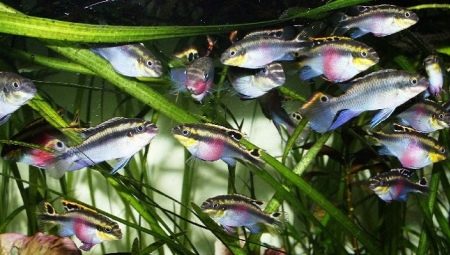Most residents of megalopolises are constantly stressed by high levels of employment and rare communication with wildlife. It is these factors that force citizens to purchase suburban homes, grow indoor plants and start pets, which help owners relax and relieve emotional stress. Psychologists recommend the most busy people to pay attention to aquariums, the maintenance of which will not only require less financial costs, but also provide an opportunity to show design skills.
All the necessary elements for decorating a home reservoir can be purchased in specialized stores, including fish, the high demand for which provoked the appearance of a large number of species and subspecies. One of the most beautiful aquatic inhabitants is pelvicachromis.


Description
Pelvikahromis pulcher is a beautiful aquarium fish that belongs to the cichlid family, has a bright appearance and a calm disposition. Many aquarists choose this species not only because of its beauty and richness of colors, but also taking into account the unpretentiousness and ease of care. Due to the appearance of the fish, they are often called parrots or cribensis.
The birthplace of this species is the reservoirs of Africa, from where in 1913 individuals were brought to Germany and began their journey around the world. The most comfortable cichlids feel in stagnant water with lots of algae.Due to the possibility of obtaining offspring at home, specialists do not capture pelvicachromis from natural reservoirs, which allowed to maintain this species and maintain its abundance at a high level. The body size of the parrots is relatively small and depends on gender. Males can grow up to 10 cm, and the length of the females does not exceed 7 cm. The skeleton of the aquatic creature has an elongated shape and flattened sides. The basic body color is brown-yellow with black stripes. The color of the abdomen is pale gray with red spots.
The peculiarity of fish is a gray dorsal fin, which runs from head to tail. The hue of the fins on the belly is always red. The shape of the tail resembles a rhombus. Depending on the conditions of detention and the internal emotional state, the fish changes the intensity and saturation of the color. Distinctive features of males are large size and large fins with dark dots. Females can be recognized by short fins, a full belly and a wide yellow stripe on the dorsal fin. During spawning, the female’s stomach turns purple-red.
In comfortable conditions of detention and subject to a balanced diet, cichlids will delight their owners for 5 years.

Variety Overview
Before you go shopping for aquarium fish of the cichlid family, experts recommend that you carefully study all types, as this family has species diversity, and the pulcher parrot has the following subspecies.
- Ordinary - A popular species that has a blue, diamond or brown-yellow spot on a basic gray background. The hue of the abdomen is red-crimson. The peculiarity is the presence of a yellow border and black spots on the tail and dorsal fin.
- Reticulate - a species whose color depends on the sex of the fish. In males it is gray-gold, and in females it is red-yellow. The maximum size of this species can reach 10 cm. A distinctive feature is the presence of red spots on the fin.
- Yellow-bellied - a beautiful view, the males of which have dark stripes on the beige body and a red fringing on the fins, but the females have a crimson tone and a turquoise shade of gills. This species can grow up to 15 cm.
- Cameroon - A parrot that is painted in a basic purple color and has dark stripes, as well as a turquoise tummy. Distinctive features of the male are purple fins and a yellow-black tail.
- Striped (changeable) - A special look that has 5 color shapes. A characteristic difference is the red fin with blue and purple spots.
- Gold-domed - an aristocratic subspecies with a golden head, yellow torso and olive fins.
- Roloffa - a light purple look that has brown fins and a white trim on the tail.
- Kribensis - The most common species, which has pointed fins, a base gray color and a cherry belly.
- Gribentis - a beautiful view, in females of which a pink-violet spot can be seen on the belly, and black spots are clearly visible on the tail and dorsal fin against a yellow background.
- Taeniatus - a very unpretentious appearance, which has an enlarged dorsal and anal fin. Against the background of the common base color, pink fins look spectacular. During spawning, the belly of females becomes saturated pink.
- Red cheek - a rare species that not all aquarists have. The main differences are the presence of red in the area of the gills, which gradually passes to the belly. The color scheme of the back is darker than in other species.
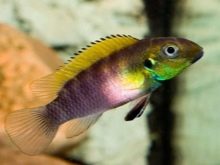
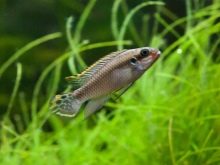
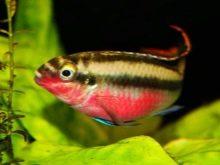
Content Features
Creating comfortable conditions for the growth and development of fish will not be difficult even for beginner aquarists who do not have both professional skills and special equipment. The thermal water level should be in the range from + 24 to + 27 degrees, the acidity should not exceed 7.5, and the hardness should not increase more than 10 units.
To calculate the optimal volume of the aquarium, you need to know the exact number of individuals. For the life of one pair, at least 40 liters of water are needed. To prevent stagnation of the contents of the aquarium, experts recommend changing at least 25% of the water weekly. It is also necessary to install aeration and filtration systems and it is imperative to purchase a water thermometer and heater that will help maintain a comfortable temperature range. Water inhabitants negatively refer to sharp temperature fluctuations and bright light.
To cover the bottom of the tank, it is better to use fine-grained or medium-fraction soil, in which there are no sharp corners. If sharp objects are placed in the aquarium, then they will certainly provoke mechanical damage to the skin of the fish during their favorite pastime - digging holes. The list of the most acceptable plants:
- moss;
- riccia;
- duckweed;
- cinema;
- Japanese fern.
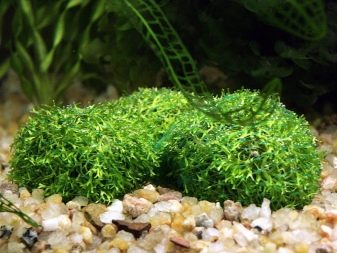
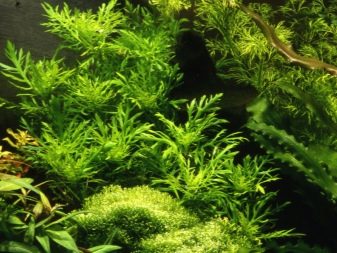
Shelters play a significant role in maintaining a stable emotional state of pets, which serve as shelters for fish in the event of an external threat. Diversified driftwood, artificial castles and grottoes, as well as a simple pile of stones will help to make these designs. Novice aquarists should pay attention to the following recommendations:
- the use of filtration plants with a minimum noise level;
- to obtain the same number of males and females, it is necessary to maintain a neutral level of acidity in the pond;
- the optimal distance of the container from the window is 150 cm;
- obligatory disinfection of all live food.
Pulvicachromis is not only an unpretentious species, but also omnivorous, in the diet of which there can be both artificial and natural feeds. To prevent the development of dangerous diseases, experienced aquarists recommend purchasing only fresh and high-quality mixtures of well-known manufacturers. As a treat you can use bloodworms, daphnia and artemia. Among herbal supplements, it is better to give preference to spirulina or small segments of fresh cucumber.
Failure to comply with the diet can provoke a significant increase in fish body weight, obesity and dropsy, which will be very difficult to cure.

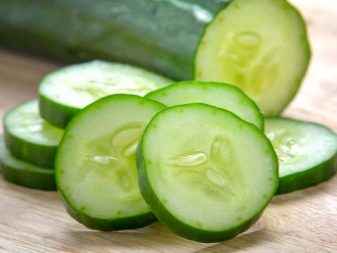
To maximize the balance of the diet, it is necessary to constantly use and alternate different types of feed and not stop on one of them. This nutrition system will have a positive effect not only on the appearance of fish and their color, but also on the functioning of the immune system, which can effectively fight various diseases. Among the most likely fish ailments, experts recommend paying attention to the following pathologies and their symptoms.
- Oodinosis - yellow coating on the surface of the whole body. Treatment is the use of copper sulfate and special medications.
- Ichthyophthyroidism - white dots and the appearance of itching.
- Tuberculosis - color change, the appearance of fading and loss of appetite, as well as the slowdown of motor processes.
- Poisoning - lethargy and bloating of the abdomen. The reasons are the excessive content of nitrogen in the water.
- Hexamitosis - the appearance of holes and mold on the head. The reason is an unbalanced diet and a lack of vitamin C.
- Eyeballs - swelling of the eyeball and its loss from the orbits. The reason is non-compliance with water requirements.
During the spawning period, it is necessary to maximize the number of live foods. To prevent the development of putrefactive processes, all food debris must be removed from the reservoir.
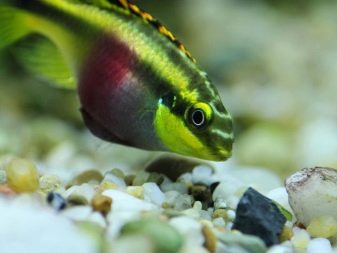

Compatible with other fish
Despite the fact that the genus of cichlids has a complex character and difficulties in finding a common language with neighbors, pelvicachromis are an exception. These marine inhabitants have a peaceful and calm disposition and easily find contact with fish the size of which does not exceed the length of their body.This feature allows owners to diversify the water world of a home reservoir. The most comfortable neighbors:
- scalaria;
- gurus
- parsing;
- all kinds of barbs;
- molliesia;
- swordsmen.
Food for cichlids can be neons, guppies, Denmark, invertebrates, larvae, eggs of other fish, small shrimps and snails. Undesirable company for parrots are large predators, such as astronotus, large species of snails, piranhas and polypteruses, which can not only bite fish, but also eat them. In the period of spawning and care for offspring, this species acquires aggressiveness and militancy, therefore, it can come into conflict with any resident of the reservoir.
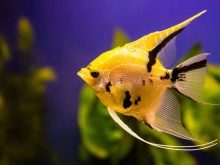
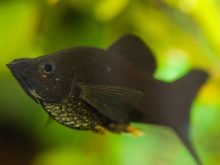
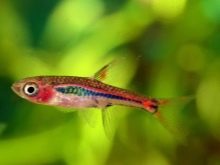
In most cases, the parrots do not use algae for food, but their habit of digging the soil can cause damage to the root system, and subsequently the death of the plant, so it is better to cover the root zone of the algae with large roots. Parrots do not have a specific predisposition to diseases, but non-compliance with sanitary and hygienic standards can provoke a decrease in immunity and the development of dangerous diseases. Among the most unfavorable factors, professional aquarists recommend paying attention to the following:
- unbalanced nutrition;
- discrepancy between the volume of the reservoir and the number of individuals living
- temperature and chemical surges of water;
- excessive lighting;
- constant exposure to noise and loud sound.
If an individual has symptoms of the disease or if it has become weak and inactive, experts recommend putting it in a separate pond and immediately begin treatment.
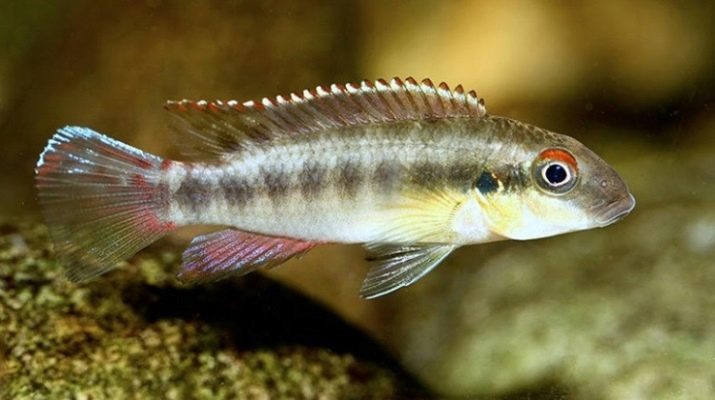
Breeding
To obtain offspring on their own, it is necessary to have a minimum amount of knowledge and comfortable living conditions for pets, which are best left in a separate pond. Sexual maturity of individuals of this species occurs at the end of the first year of life. The main feature of parrots is the formation of a strong pair that lasts throughout life. In order to speed up the spawning process, it is necessary to increase the frequency of water changes and increase the amount of live food in the diet. The first signs of spawning are the acquisition of a bright and saturated color, as well as the appearance of mating games and aggression towards other inhabitants of the aquarium.
To lay eggs, it is necessary to place a coconut shell or a broken flower pot in a container in advance. Before spawning, the formed pair starts arranging a place for the offspring, from which they remove garbage, soil and other unnecessary things. One female is able to lay from 100 to 300 red-yellow eggs, the diameter of which does not exceed 0.2 cm. This species has a very developed parental instinct, it forces the male to guard the shelter with caviar, and the female is constantly next to the offspring.
One of the important features of breeding of this species is the ability to plan the percentage of males and females in the clutch. Scientists have proven that in a more acidic environment the number of males predominates, but an increased alkaline level contributes to the appearance of females.
5 days after spawning, the eggs begin to crack, of which newborn fry appear.
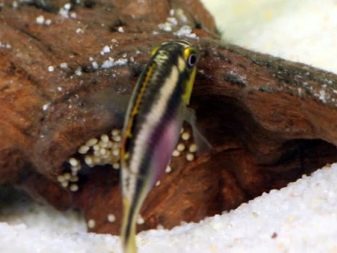
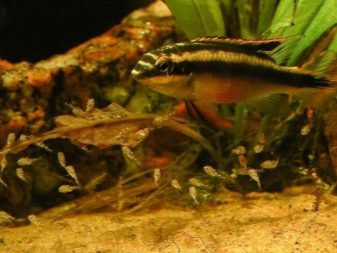
For the final formation and training in swimming, they will need at least 4 more days, and before that they are kept near the bottom. The first food for newborns is crushed boiled egg, live dust and cereal.
To maximize the preservation of offspring, experts recommend a young couple who is preparing for the first time to become parents, to remove from caviar. Out of ignorance and inexperience, young parents can begin to eat their eggs. Even after the kids begin to swim and eat on their own, the parents do not lose their vigilance and are always with them. Sometimes they bring them food, and large pieces independently chew and give to children. Two-week-old fish can be added to the diet of artemia and special food for fry.
In the first month of life, babies are covered with dark dots that allow them to hide from predators. Fishes, whose age exceeded 30 days, acquire all species features and become completely independent individuals.
Fry at the age of 90 days can be used for sale, as well as for the formation of new reservoirs.
For information on how to properly maintain Pelvikahromis pulcher fish, see the next video.
